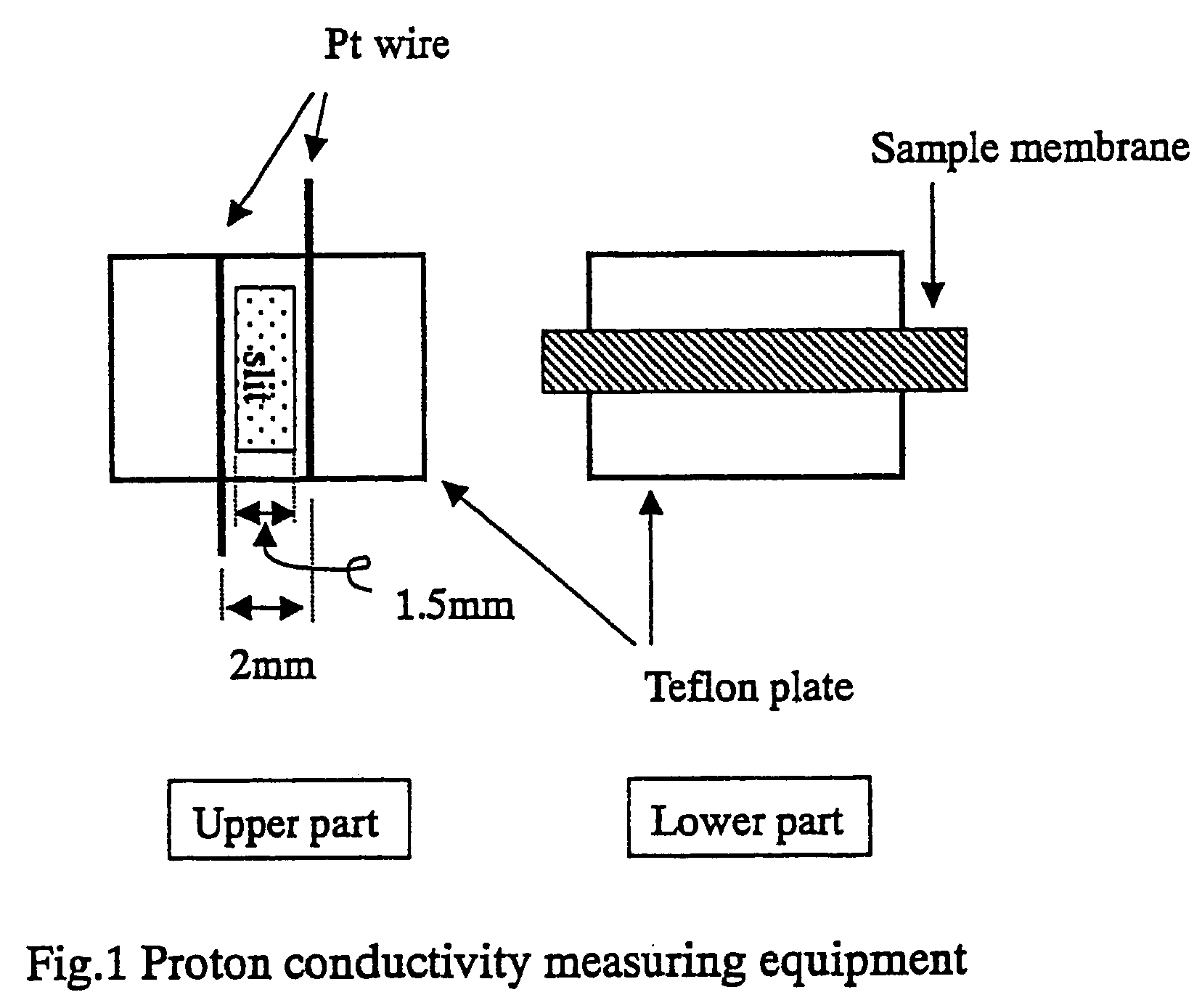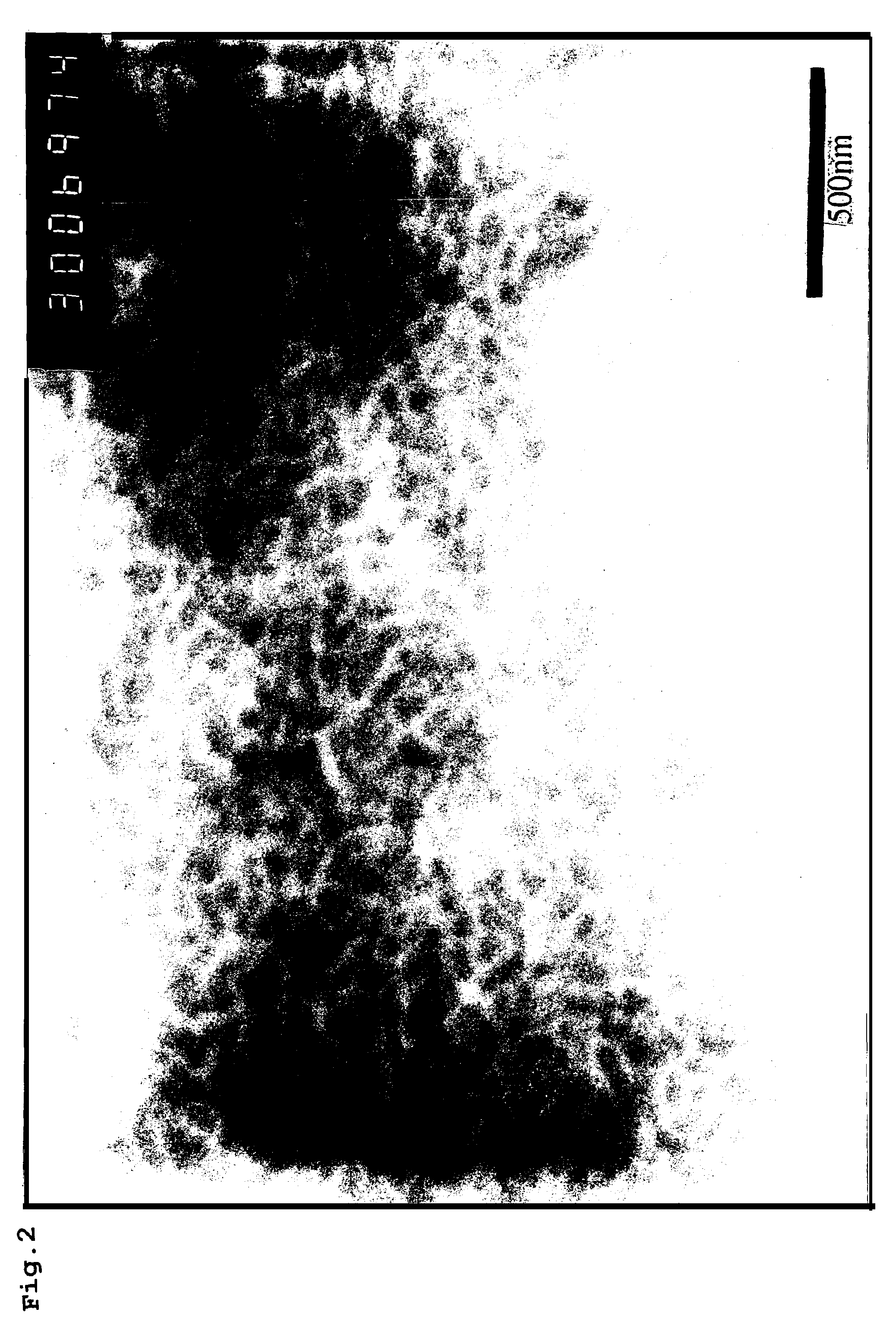Polymer electrolyte for solid polymer type fuel cell and fuel cell
a fuel cell and polymer electrolyte technology, applied in the field of polyelectrol, can solve the problems of difficult to anticipate a solution, high cost, and high cost of fluorine-based polymers, and achieve the effect of less susceptibl
- Summary
- Abstract
- Description
- Claims
- Application Information
AI Technical Summary
Benefits of technology
Problems solved by technology
Method used
Image
Examples
example 1
Polymerization for Polymer a (Hydrophobic Segment Prepolymer):
[0115]Into a four-necked flask equipped with a stirrer, a Dean-Stark trap, a thermometer, and a nitrogen inlet were charged 51.7 g of bis(4-fluorophenyl) sulfone, 50 g of bis(4-hydroxyphenyl) sulfone, and 36 g of potassium carbonate, and 300 ml of N,N-dimethylacetamide and 200 ml of toluene were added thereto. The mixture was stirred while heating in a nitrogen stream. The temperature was raised up to 165° C. while removing produced water together with toluene, and the stirring was continued at that temperature for 3 hours. The solution was poured into a large quantity of water to precipitate a white solid, which was collected by filtration. The resulting solid was washed twice in hot water and once in methanol to obtain polymer a. The resulting polymer had a reduced viscosity ηsp / c of 0.42.
Polymerization for Block Polymer BP-1 (Aromatic Polyether Sulfone Block Copolymer):
[0116]Bis(4-fluorophenyl) sulfone (25.3 g), 18.9 g...
reference example 1
Polymerization for Homopolymer B:
[0126]Polymer b was synthesized in the same manner as in Example 1, except for using the aromatic dihalide and the dihydric phenol in equimolar amounts. The solution was poured into a large quantity of water to precipitate a white solid, which was collected by filtration, washed twice in hot water and once in methanol, and dried under reduced pressure to obtain homopolymer B of polymer b. The resulting homopolymer B had a reduced viscosity of ηsp / c of 0.58.
Sulfonation of Homopolymer B:
[0127]Ten grams of homopolymer B was dissolved in 100 ml of 98% sulfuric acid, followed by stirring at room temperature for 24 hours. The solution was poured into a large amount of 1N hydrochloric acid to precipitate a white solid. The solid was collected by filtration, washed twice in 0.5N hydrochloric acid, and dried at 80° C. under reduced pressure to give sulfonated homopolymer B, which was water-soluble. The resulting polymer had an ion exchange capacity of 3.5 mmo...
example 2
Polymerization for Block Polymer BP-2 (Aromatic Polyether Sulfone Block Copolymer):
[0130]Bis(4-chlorophenyl) sulfone (18.2 g), 12 g of 4,4′-biphenol, and 11.6 g of potassium carbonate were put in, and 150 ml of N,N-dimethylacetamide and 100 ml of toluene were added thereto. The mixture was heated while stirring in a nitrogen stream. The temperature was raised up to 165° C. while removing produced water together with toluene, and the stirring was continued for 3 hours at that temperature to prepare a solution of polymer c. Separately, 45.5 g of polymer a synthesized in Example 1 was added to a mixture of 150 ml of N,N-dimethylacetamide and 100 ml of toluene, and the solution was heated up to 165° C. in a nitrogen stream while removing produced water together with toluene to prepare a solution of polymer a. The polymer a solution was added to the polymer c solution, and the mixture was stirred at 170° C. for 2 hours. The solution was poured into a large amount of water to precipitate ...
PUM
| Property | Measurement | Unit |
|---|---|---|
| Power | aaaaa | aaaaa |
| Nanoscale particle size | aaaaa | aaaaa |
| Molality | aaaaa | aaaaa |
Abstract
Description
Claims
Application Information
 Login to View More
Login to View More - R&D
- Intellectual Property
- Life Sciences
- Materials
- Tech Scout
- Unparalleled Data Quality
- Higher Quality Content
- 60% Fewer Hallucinations
Browse by: Latest US Patents, China's latest patents, Technical Efficacy Thesaurus, Application Domain, Technology Topic, Popular Technical Reports.
© 2025 PatSnap. All rights reserved.Legal|Privacy policy|Modern Slavery Act Transparency Statement|Sitemap|About US| Contact US: help@patsnap.com



